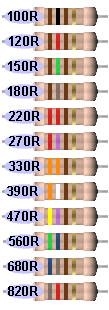RESISTOR VALUES MADE EASY
5%
Commonly called the "3-colour"
system
Click HERE for 1% and 2%
resistors
Surface Mount
identification
Match the colors to get the
value of resistance:
 |
 |
 |
 |
 |
 |
 |
 |
NOTES:
The resistors above are "common value" 5% types.
The fourth band is called the "tolerance" band. Gold = 5%
(tolerance band Silver =10% but no modern resistors are 10%!! - they are 5% or 1%)
"common resistors" have values 10 ohms to 22M.
RESISTORS LESS THAN 10 OHMS
When the third band is gold, it indicates the value of the "colors" must be divided by 10.
Gold = "divide by 10" to get values 1R0 to 8R2
See 1st Column above for examples.
When the third band is silver, it indicates the value of the "colors" must be divided by 100. (Remember: more letters in the word "silver" thus the divisor is "a larger division.")
Silver = "divide by 100" to get values R1 to R82
e.g: 0R1 = 0.1 ohm 0R22 = point 22 ohms
See 4th Column above for examples.
The letters "R, k and M" take the place of a decimal point.
e.g: 1R0 = 1 ohm 2R2 = 2 point 2 ohms 22R = 22 ohms
2k2 = 2,200 ohms 100k = 100,000 ohms
2M2 = 2,200,000 ohms
COLOUR CODE
HOW TO REMEMBER THE COLOUR CODE:
Each colour has a "number" (or divisor) corresponding to it.
Most of the colours are in the same order as in the spectrum. You can see the spectrum in a rainbow. It is: ROYGBV and the colours for resistors are in the same sequence.
black
brown - colour of increasing temperature
red
orange
yellow
green
blue
violet
gray
white
| colour | value | No of zero's |
| silver | -2 | divide by 100 |
| gold | -1 | divide by 10 |
| black | 0 | No zeros |
| brown | 1 | 0 |
| red | 2 | 00 |
| orange | 3 | ,000 or k |
| yellow | 4 | 0,000 |
| green | 5 | 00,000 |
| blue | 6 | M |
| violet | 7 | |
| gray | 8 | |
| white | 9 |
Here are some common ways to remember the
colour code:
Bad Beer Rots Our Young Guts, But Vodka Goes Well
Bright Boys Rave Over Young Girls But Violet Gets Wed
Bad Boys Rave Over Young Girls But Violet Gets Wed with Gold and
Silver.